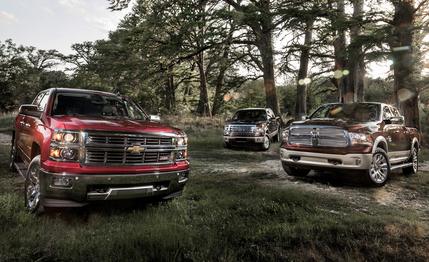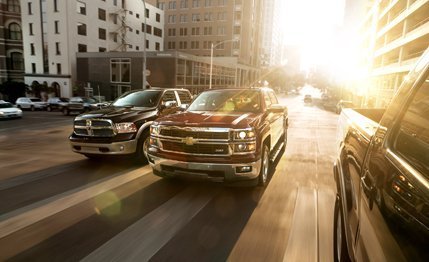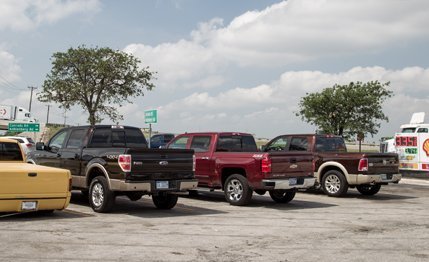
 Comparison Tests
Comparison Tests
You know who simply loves Texas? Swine, that’s who.
Well, feral swine to be more specific. Oh, and pickup-truck drivers, of course. They also love Texas. The one-time independent republic is overrun with both. Truckmakers can’t seem to agree on exactly what proportion of pickups sold is delivered in Texas, except to acknowledge that it’s a truck-load of ’em. Chevrolet estimates that one in six new full-size pickups is sold in Texas, while Ram reckons it’s more like one in five. Either way, those two big players, along with Ford, are so fond of Texas shoppers that each makes some variety of Texas-specific edition of its truck.
According to a 2012 study by Texas A&M University, the feral hog population in the state is somewhere between 1.8 million and 3.4 million. These crafty omnivores are highly adaptable descendants of escaped domesticated pigs, of wild Eurasian boars, and of a hybrid of multiple sources of swine stock. They are unusually fecund; sows begin breeding at six to eight months of age and have two litters of about four to eight piglets every 12 to 15 months. They will live almost anywhere. They eat almost anything. They will damage just about any environment they encounter. A full-grown adult weighs in at between 150 and 400 pounds. And they have a quite high probability of being shot.
They are, then, fairly typical Americans.
The country’s population of pickups has exploded during roughly the same 30-year time period as the wild pigs’ boom. But in contrast to the wild swine, this species has become more and more domesticated with each generation, to the point that the current litter of trucks has an almost minivan-like obsession with family-friendly doodads. (A heated steering wheel? That’s like some kind of New-York-City truck!)


And so it was with all of this in mind that we traveled to central Texas to sample these three not-so-little piggies on their home turf. Well, that and the fact that Chevrolet happened to be unveiling its new Silverado to the automotive press in San Antonio (because Texas!). The introduction of the all-new Silverado was the impetus for this gathering.
From the moment the 2014 Silverado was unveiled at this year’s Detroit auto show, it’s drawn fire for looking too similar to the outgoing model. How’s that for changed expectations in the pickup market? We, however, have no problem with a truck that looks like a truck, even if it happens to look like a truck used to look. We specified the volume model of the lineup, which is a four-door version powered by the 5.3-liter gen-five small-block V-8. A 4.3-liter V-6 and a 6.2-liter V-8 also will be offered. This new pushrod 5.3 comes with fuel-saving cylinder deactivation, direct injection, and variable-valve timing.
The new-age small-block is Chevy’s biggest play for improving fuel economy, a modern priority even among these heavy drinkers. Our 4x4 version is rated by the EPA at 16 mpg in the city and 22 on the highway, one mpg up in both tests over the outgoing 5.3-liter–powered Silverado with the same six-speed automatic.
Other than that, the Chevy has no standout technical feature like the F-150’s turbocharged and direct-injected V-6 or the Ram’s adjustable-height air springs. On first look, then, it appears to be as mechanically conservative as its blocky styling suggests. Our ruby-red example came with the LTZ and Driver Alert packages, to highlight most of the Chevy’s new toys, and carried a $50,755 price tag.


Ford insisted on entering this contest with its optional turbo V-6 ($1095), which the company views as an alternative to conventional V-8s. We asked for a truck with the company’s most popular engine and, according to Ford, the EcoBoost V-6 slightly outsells the 5.0-liter V-8 available in the F-150. And, indeed, the turbo V-6 makes V-8 horsepower—10 horses up on Chevy’s 5.3 and not much less powerful than Ram’s 5.7-liter Hemi. By now you should know that this EcoBoost prioritizes Boost over Eco. The EPA rates the Ford’s fuel economy even with the Ram’s and slightly worse than the Chevy’s. That all three of our trucks averaged 13 mpg over 500 miles of mixed terrain indicates two things: We used full throttle more frequently than was strictly necessary, and the EcoBoost V-6 is like a V-8 in essentially every respect, except it doesn’t sound as good. Despite its optional engine, our Lariat-level 4x4 SuperCrew F-150 was the cheapest truck in the test at a not-at-all cheap $49,725.
The Ram 1500 is our reigning full-size pickup champ. And the Ram folk loaded up a brown-and-tan Ram 1500 Laramie Longhorn Edition Crew Cab to the tune of $55,390, including the Hemi V-8, optional air springs ($1595), and enough cowboy filigree that even the “cowboy” from the Village People might consider it a bit flamboyant.
The updated version of the Texas-built Toyota Tundra was not available in time for this comparison.
In honor of the wide-ranging usage patterns of modern pickup trucks, we steered clear of the cattle-ranch and rodeo clichés and trundled around in the sea of strip malls that is outer San Antonio. We got stuck in impossibly confined parking garages in Austin’s hipster-filthy South Congress neighborhood, endured a lifetime’s worth of Country Music Television at the Buckhorn Bar and Grill in rural Leakey—where nothing appears to have ever been wet enough to leak—and ate barbecue at a gun store/taxidermy shop in Uvalde.
We never did see a wild boar, by the way.